Composer Charles Shadle releases a new work, "Choctaw Animals"
Four pieces for piano that honor his Native American heritage

Charles Shadle is arguably the most visible living classical composer in the Choctaw tribe, and he does not want to be the last. Thinking of young Choctaw children in rural communities he says, “To some extent, I can say, you could be a composer too. Your voice can be heard.”
Gallery: Native American and Indigenous Perspectives at MIT
Scholarship, education, and creativity in MIT's humanistic fields
Charles Shadle was just 10 years old when he was entrusted with a precious family heirloom: a book of music that his great-great-great-grandmother had brought with her on the Trail of Tears, the forced removal of Native Americans to Oklahoma from their southeastern homelands beginning in the 1830s.
Today, this extraordinary gift remains a symbol of two significant threads interwoven in Shadle’s life: music and his Choctaw heritage. “There was usually a person in every generation that music was important to, and I was the one in my generation,” says Shadle, a senior lecturer in music at MIT and an enrolled Oklahoma Choctaw.
The fact that his ancestor carried the book on the journey illustrates the importance of music to the Choctaw, Shadle explains. “I think it’s true of any immigrants,” he says. “Once you get past the essentials, what you take with you has real cultural significance.”
Now an accomplished composer, Shadle has received commissions from many institutions over the years, including Lake George Opera Festival, the Handel and Haydn Society, the Syracuse Symphony Orchestra, and the Rockport Chamber Music Festival. But recently, he created a simpler series of compositions that he hopes will provide an accessible introduction both to music and to Choctaw traditions.
“I have written a number of pieces that explore aspects of my Choctaw heritage, such as ‘Limestone Gap,’ ‘Red Cedar,’ and ‘The Old Place’ (all commissioned by the acclaimed, London-based ensemble Lontano), but these works tend to be rather difficult, requiring numerous highly accomplished players. Since this naturally limits the number of people who can experience my music, I decided to compose a set of much more accessible piano pieces,” he says.
“Choctaw Animals” is a series of four pieces intended for pianists of all ages and abilities. “My thought was that they could be played by young people taking piano lessons,” Shadle says. “They’re as simple as I could make them and still have them sound like my music.”
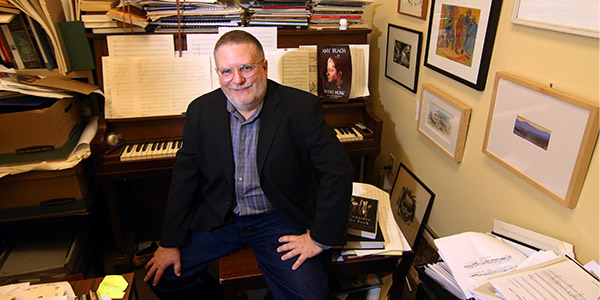
Charles Shadle, MIT Composer; photograph by Allegra Boverman
"Choctaw Animals: Four Not-Too-Difficult Pieces for Piano"
View and download the Sheet Music + Composer's Commentary
Listen to the recordings: Chulhkvn | Nvni | Nashoba | Issuba
Performed by the composer in MIT's Killian Hall, Nov. 2020; Joel Gordon, producer/recording engineer
Inspired by tradition
With titles in Choctaw, each piece reflects the character of a particular creature, Shadle says. For example, “Chulhkvn” (pronounced choth-kan,) or “Spider,” is a piece that weaves together musical lines the way a spider might weave silk. “Issuba,” which means “Pony,” features a rhythm reminiscent of hoof beats. The other two pieces are “Nvni,” which means “fish,” and “Nashoba,” which means “wolf.”
Some of the creatures have strong ties to Choctaw heritage — the spider, for example, is credited in folklore with bringing fire to the people — but Shadle says he chose others primarily because it was enjoyable to represent the animals musically. “Maybe the wolf is my favorite,” he says, describing the piece as quiet and mysterious. “It’s almost as if we never see the wolf, we just sort of sense that it’s there.”
In all cases, Shadle says, the compositions draw on elements of Choctaw music-making, notably the tribe’s tradition of social dance. “I focused on using melodic patterns and rhythmic configurations that are inspired by this tradition, without ever quoting any of the actual dance songs,” Shadle says. While reimagining traditional songs can be very successful artistically, he explains, “among the people whose music is used, that can feel like a violation, like something taken from them. I didn’t want to participate in that.”
Chulhkvn / Spider
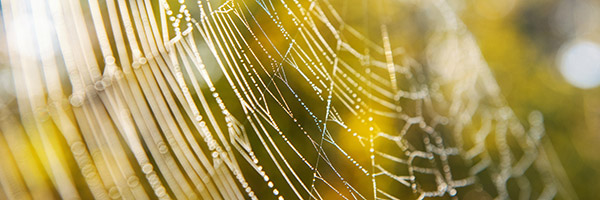
“Chulhkvn” (pronounced choth-kan,) weaves together musical lines the way a spider might weave silk. Choctaw "choker" necklaces also have a weblike quality that pays homage to the spider, who, in Choctaw folklore, is credited with bringing fire to the people. Listen to "Chulhkvn"
Nvni / Fish
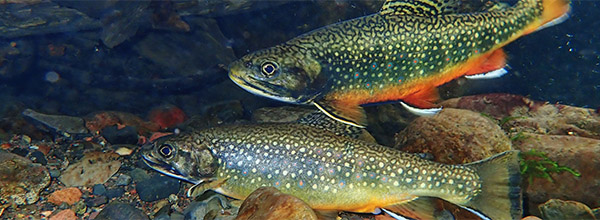
The word "Nvni" rhymes with “honey.” Shadle says that the movements of the fish, as it darts through murky water provided the inspiration for this piece. Listen to "Nvni"
An identity connected to the land
Shadle says he hopes his work will provide performers and listeners with some insight into Choctaw traditions and perhaps even introduce them to a part of the country they don’t know. “My corner of Oklahoma isn’t a part that most people think about very much,” he says, explaining that his music is deeply rooted in the landscape. “That connection with place, with land, with heritage, are always inextricably linked.”“That feels to me to come from a singularly Choctaw part of myself,” he adds.
And, while that might seem strange, given that the Choctaws were forced off their ancestral lands, Shadle says he thinks the traumatic move to Oklahoma (which led to the deaths of an estimated 4,000 of the 20,000 Choctaw who were relocated) actually deepened the tribe’s connection to the land. “The Choctaw had mostly owned land communally before the 19th century. When they got to Oklahoma, they had the sense they had to hold onto the land,” he says, noting that members of the tribe now own land as individuals. “Our identity is connected to the land because it was taken from us at one point.”
Nashoba / Wolf
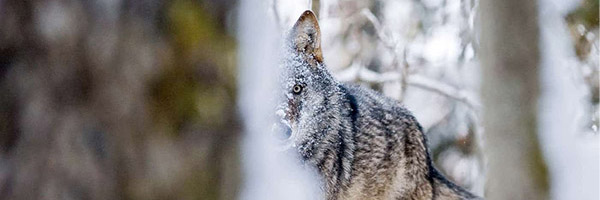
“Maybe the wolf is my favorite,” says Shadle, describing the "Nashoba" piece as quiet and mysterious. “It’s almost as if we never see the wolf, we just sort of sense that it’s there.”
Listen to "Nashoba"
Issuba / Pony
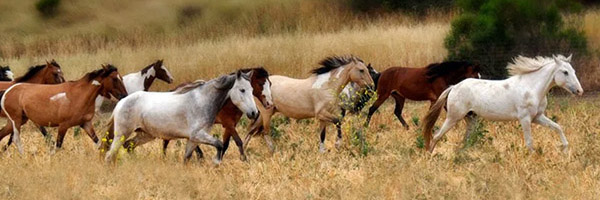
Choctaw pony herd; Image courtesy of the Return to the Wild
"This pony, a rare and historically important breed that is actively being brought back from near extinction, has come to symbolize the qualities of resilience and strength that characterize the Choctaw people, Shadle says. "The music of this piece reflects the rhythm of hoof-beats, and is joyful and optimistic." Listen to "Issuba"
Ultimately, Shadle hopes his work builds connections — between music and his Choctaw heritage, between classical music and traditional music, and between generations of Choctaw. “I want to make sure I’m acting as a conduit for people who may come after me,” he says, noting that he is arguably the most visible living classical composer in the Choctaw tribe, and he does not want to be the last. “I’m interested in the young Choctaw girl or boy in some rural community,” he says. “To some extent, I can say, you could be a composer too. Your voice can be heard.”
Shadle is also happy to have the opportunity to share his heritage with MIT, since he is one of just two Native Americans on the faculty; the other is David Robertson, a Senior Lecturer in the Sloan School of Management who is Cherokee. "David and I are the only two people who have ever taught full time at MIT who are Native American. There has never been a tenured faculty member,” Shadle says. However, there is a Native American Student Association on campus, and Shadle sees efforts to give that group meeting space as a sign of progress for a broad and diverse group of people that includes the Choctaw and hundreds of other tribes.
“If a group gets space at MIT, they count — and I think we’re seeing that happening for Indigenous students.”
• • •
Warm thanks for their contributions to Seth Fairchild, Executive Director, Chahta Foundation; Audrey Jacob, Director of Art, Choctaw Cultural Center; and Joseph Wolf, of the Choctaw Nation of Oklahoma.
Suggested Links
Charles Shadle
Composer, MIT Music Faculty
Gallery: Native American and Indigenous Perspectives at MIT
Scholarship, education, and creativity in MIT's humanistic fields
Sheet music + composer's commentary for “Choctaw Animals"
Listen to "Choctaw Animals": Chulhkvn | Nvni | Nashoba | Issuba
Performances by the composer in Killian Hall, MIT, Nov. 2020; Joel Gordon, producer and recording engineer
More music by Charles Shadle:
3rd Symphony, MIT Music site
Penny Ballad, MIT Listening Room
A Tale of My Native Land, YouTube
Red Cloud, YouTube
MIT Music and Theater Arts | MIT Music Program
Musical Institute of Technology
Online book about Music and the MIT mission
A Guide to Indigenous Land Acknowledgment
MIT Native American Student Association (NASA)
MIT American Indian Science and Engineering Society (AISES)
Choctaw Nation website
History and Culture
Cultural Services
Language
About via Wikipedia
About via Wikiwand
Map of Choctaw Nation Boundaries
National Museum of the American Indian (NMAI)
Choctaw content and materials at the NMAI
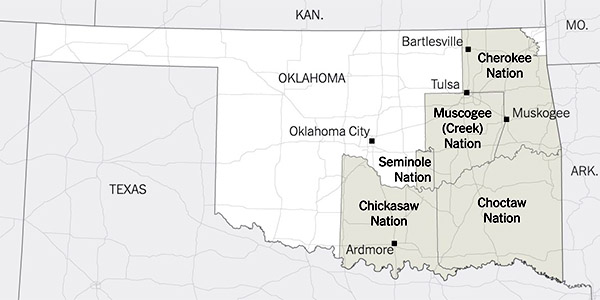
Map showing the locations of the Choctaw Nation and other Native American tribes in Oklahoma
A Guide to Indigenous Land Acknowledgment
Prepared by MIT SHASS Communications
Office of Dean Melissa Nobles
Editor and Designer: Emily Hiestand, Communication Director
Senior Writer: Kathryn O'Neill
"Choctaw Animals" performed by the composer; Joel Gordon, producer and recording engineer